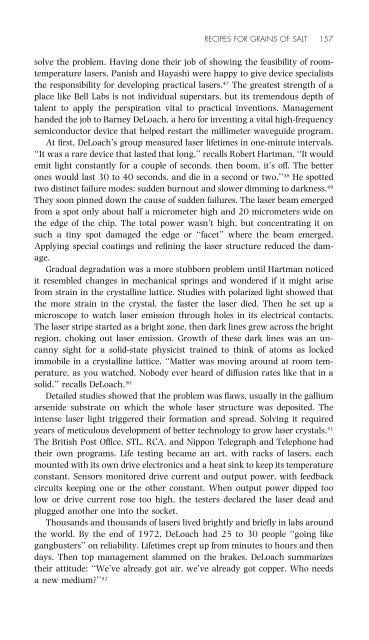City of Light: The Story of Fiber Optics
City of Light: The Story of Fiber Optics
City of Light: The Story of Fiber Optics
Create successful ePaper yourself
Turn your PDF publications into a flip-book with our unique Google optimized e-Paper software.
RECIPES FOR GRAINS OF SALT 157<br />
solve the problem. Having done their job <strong>of</strong> showing the feasibility <strong>of</strong> roomtemperature<br />
lasers, Panish and Hayashi were happy to give device specialists<br />
the responsibility for developing practical lasers. 47 <strong>The</strong> greatest strength <strong>of</strong> a<br />
place like Bell Labs is not individual superstars, but its tremendous depth <strong>of</strong><br />
talent to apply the perspiration vital to practical inventions. Management<br />
handed the job to Barney DeLoach, a hero for inventing a vital high-frequency<br />
semiconductor device that helped restart the millimeter waveguide program.<br />
At first, DeLoach’s group measured laser lifetimes in one-minute intervals.<br />
‘‘It was a rare device that lasted that long,’’ recalls Robert Hartman. ‘‘It would<br />
emit light constantly for a couple <strong>of</strong> seconds, then boom, it’s <strong>of</strong>f. <strong>The</strong> better<br />
ones would last 30 to 40 seconds, and die in a second or two.’’ 48 He spotted<br />
two distinct failure modes: sudden burnout and slower dimming to darkness. 49<br />
<strong>The</strong>y soon pinned down the cause <strong>of</strong> sudden failures. <strong>The</strong> laser beam emerged<br />
from a spot only about half a micrometer high and 20 micrometers wide on<br />
the edge <strong>of</strong> the chip. <strong>The</strong> total power wasn’t high, but concentrating it on<br />
such a tiny spot damaged the edge or ‘‘facet’’ where the beam emerged.<br />
Applying special coatings and refining the laser structure reduced the damage.<br />
Gradual degradation was a more stubborn problem until Hartman noticed<br />
it resembled changes in mechanical springs and wondered if it might arise<br />
from strain in the crystalline lattice. Studies with polarized light showed that<br />
the more strain in the crystal, the faster the laser died. <strong>The</strong>n he set up a<br />
microscope to watch laser emission through holes in its electrical contacts.<br />
<strong>The</strong> laser stripe started as a bright zone, then dark lines grew across the bright<br />
region, choking out laser emission. Growth <strong>of</strong> these dark lines was an uncanny<br />
sight for a solid-state physicist trained to think <strong>of</strong> atoms as locked<br />
immobile in a crystalline lattice. ‘‘Matter was moving around at room temperature,<br />
as you watched. Nobody ever heard <strong>of</strong> diffusion rates like that in a<br />
solid,’’ recalls DeLoach. 50<br />
Detailed studies showed that the problem was flaws, usually in the gallium<br />
arsenide substrate on which the whole laser structure was deposited. <strong>The</strong><br />
intense laser light triggered their formation and spread. Solving it required<br />
years <strong>of</strong> meticulous development <strong>of</strong> better technology to grow laser crystals. 51<br />
<strong>The</strong> British Post Office, STL, RCA, and Nippon Telegraph and Telephone had<br />
their own programs. Life testing became an art, with racks <strong>of</strong> lasers, each<br />
mounted with its own drive electronics and a heat sink to keep its temperature<br />
constant. Sensors monitored drive current and output power, with feedback<br />
circuits keeping one or the other constant. When output power dipped too<br />
low or drive current rose too high, the testers declared the laser dead and<br />
plugged another one into the socket.<br />
Thousands and thousands <strong>of</strong> lasers lived brightly and briefly in labs around<br />
the world. By the end <strong>of</strong> 1972, DeLoach had 25 to 30 people ‘‘going like<br />
gangbusters’’ on reliability. Lifetimes crept up from minutes to hours and then<br />
days. <strong>The</strong>n top management slammed on the brakes. DeLoach summarizes<br />
their attitude: ‘‘We’ve already got air, we’ve already got copper. Who needs<br />
a new medium?’’ 52

















